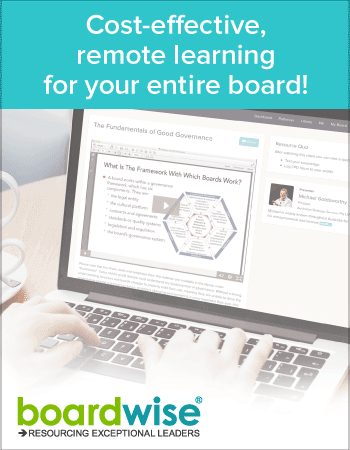The Business of Board and Committee Meetings
-
governance
Governance The Business of Board and Committee Meetings
The Complex Task of Board Decision-Making
Around the world there are countless books, articles, journals and papers written about Management, Management Theory, Governance, the functions of Boards, and so on. The world is much taken up with trying to guide those tasked with making decisions, shadowed by an increasingly complex body of regulation and obligation falling to those holding Board and or Committee positions.
Individuals with differing backgrounds, experiences and values come together to evaluate information, form a collective view and make decisions, about matters that often have competing interests; being on a Board or Committee can sometimes seem complex and onerous.
The Simple Mechanics of Meetings
The business of conducting a Board or Committee meeting is, however, quite a simple affair. A number of people get together, either physically or virtually, gathered around an Agenda detailing matters requiring noting, or a decision. Agenda items are accompanied by background information. This informs a discussion involving individual and collective consideration and evaluation, informing a vote which leads to a decision. If a decision isn’t required, then the Board will note the information presumably for future use.
No matter how many new text books are written, and no matter how technical the academics might make it, the simple fact is every Board or Committee meeting is in the business of setting an agenda, distributing background information, discussing and evaluating matters, and either noting information for future use, or for making a decision requiring a vote.
The Burden of Manual Administration
For many Executive Officers or Secretaries to Boards, preparing the mechanics of meetings takes place in an old fashioned manner involving photocopying, collating, binding and posting or couriering. Records are held in burgeoning physical folders or archives, and references to past decisions are difficult to find.
If making decisions on Boards can be complicated, the process of organising and supporting the meeting need not be. Executive Assistants spend many hours photocopying forests of paper, then there’s the mind-numbing job of compiling and binding papers followed by the costly business of sending papers out, usually by courier.
Introducing Automation and Cloud Technology
Our Cat Herder is a Cloud-based Board and Committee management portal removing all paper, manual handling and courier/postage costs. Board or Committee members receive all papers online, and a secure chatroom is provided for discussion in-between meetings. If members are delegated tasks as follow up actions then Our Cat Herder sends gentle reminders to their email. All past Minutes, Strategic Plans and Constitutions and other important documents can be stored in the Archive for 24/7 reference.
Our Cat Herder brings Board and Committee management into the 21st Century, and it saves money.
Optimising Administration for Productivity
While the business of making decisions in Board and Committee meetings can be complex, the process of administering and supporting meetings does not have to be. Advances in technology allow for streamlining and automation of many administrative tasks. Cloud-based portals reduce the need for printing, collating, binding and mailing physical documents. They provide secure online access to documents and records anytime, anywhere. Workflow tools track action items and send automated reminders. Digital archives store documents sustainably.
Executive Officers and Secretaries still play a critical role in Board administration, but tools like Our Cat Herder allow them to focus their time and energy on high-value responsibilities. Scheduling meetings, setting agendas, liaising between members, and providing procedural advice remain essential human responsibilities. But technology can eliminate the drudgery of copying, mailing, filing and data entry.
Organisation-Wide Benefits
The benefits extend throughout an organisation. Board members can access materials conveniently without the hassle of paperwork. Leadership teams save time otherwise spent on administrative tasks. Finance teams reduce expenses from printing, postage and archiving. IT teams avoid maintenance of on-premise servers. The organisation cuts its carbon footprint by going paperless.
In a fast-paced business climate, Board members have limited time and attention. Optimising the meeting workflow and administration process allows them to focus on oversight, governance and strategic guidance of the organisation. Streamlined administration also provides continuity for Boards with rotating member terms. Onboarding new members is easier when past materials are organised and accessible in a central archive.
Embracing Digital Transformation
While some Boards and Committees still prefer the tangible, tactile experience of paper documents and in-person meetings, going digital offers too many benefits for most to ignore. As younger generations enter leadership roles, they expect the convenience and sustainability of cloud-based tools for collaboration and governance.
The fundamentals of good governance and leadership do not change. But leaders have a responsibility to leverage technology to improve efficiency and reduce waste. Tools tailored to Board administration allow leaders to model innovation and environmental stewardship. Wise Boards will assess how digitising their operations can uphold fiduciary duties while delivering benefits to the organisation and its stakeholders.
Frequently Asked Questions
How can boards balance the complexity of decision-making with the logistics of running efficient meetings?
Boards can focus meeting time on substantive discussions and evaluations by streamlining administrative tasks like document distribution through cloud-based portals that provide easy online access and reduce manual work. This allows more time for weighing options and making informed decisions.
What are some of the main administrative burdens on boards and how can they be simplified?
Major burdens include manually copying, collating and mailing board packets, tracking action items across multiple systems, and organising records in physical folders, which can be significantly reduced through automation tools and online collaboration platforms that centralise document sharing, scheduling, reminders, and searchable archives.
What types of cloud-based tools are available to help automate board administration and collaboration?
Cloud platforms provide integrated portals with robust features like automated document sharing, meeting scheduling, member reminders, group chat functions, and searchable archives to streamline and consolidate meeting management tasks in one secure online system accessible anywhere.
How can digitising operations benefit an organisation financially and environmentally?
Digitising board and committee operations can substantially reduce printing, postage, paper, and physical storage costs while decreasing paper usage, waste, and carbon emissions for major financial savings and environmental sustainability benefits.



